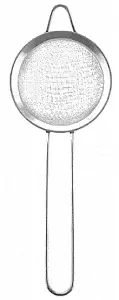Besides cocktail shaker (which you can read all about what kind of cocktail shaker is the right one for you in our previous Types Of Cocktail Shakers article.)
There are a lot of “must have” tools in a well equipped home bar, in this article we will show you the basic ones, and in the next article we’ll take it to the next level 😉
Recommended Bar Accessories
Bar Spoon:
The bar spoon is used for a host of functions ranging such as layering and mixing, but primarily it is used for stirring cocktails. When it comes to stirring, it is all about balance and comfort, so our recommendation is always the type with spirals. Also, depending on its make, it can be used in the absence of a muddler.
There are basically three types of bar spoons. They include:
🔴 The European Bar Spoon:
A distinctive feature of the European bar spoon is the round disk at its tip which can be used to muddle ingredients and layer drinks.
💭Uses:

✅ Layering: The disk and the twisted stem are used in layering drinks. The spirit is poured down the twist, where it travels down the stem to the disk before spreading.
✅ Muddling: This variety of bar spoon can be used for muddling owing to the disc at its tip. However, owing to fragility, it cannot totally replace a standard muddler, and can only be used to muddle soft ingredients which only require bruising.
🔴 The American Bar Spoon:
This variety of bar spoon has a basic design with a twist at the middle of the shaft and a rubber cap at its tip. The function of the rubber cap is to protect the hand of its users against injuries while in use.
💭Uses:

✅ Stirring: The spoon is basically used for only stirring because of an obvious lack of the features present in the European and Japanese bar spoons.
🔴 The Japanese Bar Spoon:
The Japanese bar spoon typically has a longer length than the American and European bar spoons. It has a distinctive tear drop design or a bar fork at its tip and a twisted shaft. The teardrop design in some varieties give it extra weight which make for better handling when stirring. The fork design on the other hand is useful in picking up ingredients.
💭Uses:

✅ Garnishing: The bar fork design makes it easier to pick and handle fruits when cutting.
✅ Layering: The twisted stem means it can be used in layering cocktails.
Cocktail strainer:
A cocktail strainer is used in separating the solid and liquid constituents of a cocktail. They prevent pulp, mashed up fruit, and ice from getting into the drink when serving. There are three types of cocktail strainers:
🔴 Hawthorne Strainer:
The Hawthorne strainer is the most popular type of strainer which can be easily fitted into a mixing container. It has a special spring that ensures that all fruits and herbs stay inside the shaker. Also, it is adjustable owing to ears which makes it easy to move during pouring.

✅Inexpensive.
✅Capable of fitting many different containers.
✅Adapts several sizes for efficiency.
✅The advised variant for beginner mixologists.
Cons:
❌Damages easily when aggressively used.
❌Cleaning might prove to be a hassle because of its features.
🔴 Julep Strainer
The Julep strainer has large holes and is useful in straining drinks that have been stirred. The absence of ears means the user is required to hold up the strainer during use. Once placed over the glass, the strainer is held with the help of a depression when the bartender can apply pressure with their finger. The Julep strainer can be easily swapped for the Hawthorne or fine mesh strainer.

✅Fits mixing glasses better.
✅More durable than every other type of cocktail strainers.
Cons:
❌It makes the draining process slow.
🔴 Fine Mesh Strainer:
This strainer type is useful as an additional filter to keep out particles like ice and fruits. The fine mesh strainer comes in different sizes and can be used in conjunction with other shaker types for extra smoothness.

Pros:
✅Inexpensive.
✅Gives drink a smooth edge.
Muddler:


With each turn of the muddler, the juices, oils, and even the flesh of the fruit are released into the bottom of the glass. If you have ever tasted a full of flavors and freshness cocktail, those fresh flavors of ingredients in your drink were probably because of proper muddling. Without it, all the “extras” (herbs, spices and fruit) do not reach their full potential.
Wood, plastic and metal are the main types of muddler while there are also muddler head styles such as: Flat, toothed, spiked and textured. Muddlers are available in a huge variety of styles, yet a few small variations making the big differences. Since world of muddlers is an issue in and on itself, we expand more about it in our next guide :).
Jigger:

Using a jigger is highly recommended for beginners. Free pouring might be accurate if you’re an experienced bartender or mixologist (and it’s definitely faster), but there’s a reason why most cocktail bars prefer to use jiggers. It’s the most reliable way to accurately measure the amounts of each ingredient in your drink.
There are many options when choosing a jigger, but many bartenders choose the cone shape, tall and small jiggers.
Liquor pourers:

The speed or bottle pourer is fitted inside the bottle neck and giving you greater control over the amount of alcohol that is poured. Accuracy, efficiency and clean work area are the name of the game when using them.
While some might say speed pourers are only nice-to-have addition to amateur bartenders (who make cocktail at home bars), we think that speed pourers are one of the most underrated equipment in home bars. It is undoubtedly a more essential tool for the professional bartender than beginners, since you want to avoid spills and splashes.



